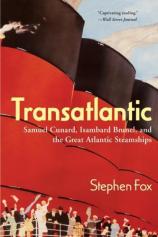Transatlantic: Samuel Cunard, Isambard Brunel, and the Great Atlantic Steamships
Review
Transatlantic: Samuel Cunard, Isambard Brunel, and the Great Atlantic Steamships
Perhaps the most interesting tidbit in TRANSATLANTIC, a book full
of great tidbits, is that none of the great passenger liners
celebrated in its pages are afloat today. Those that are in
existence are rusting away quietly at the bottom of the North
Atlantic --- the Titanic being the most renowned of the wrecks, but
hardly alone. None of the others are left, being victims of time or
of sinking or of the knacker's yard. The genius of historical
preservation stretches back to the age of sail --- USS
Constitution, USS Constellation, HMS Victory --- and forward to the
age of flight --- the Wright Brothers' Flyer, a contemporary of
many of the great transatlantic ocean liners, is extant at the
Smithsonian --- but seems to have skipped the age of steam.
If the great liners are remembered at all, they will have to be
remembered in the pages of TRANSATLANTIC, and the book is certainly
monumental enough for that.
Author Stephen Fox has written a thick book but an immensely
valuable one. TRANSATLANTIC begins at the dawn of its era,
when steam engine technology and metalworking knowledge became
advanced enough to imagine a great ship, powered by steam,
independent of wind and tide, crossing the cold and forbidding
distances of the North Atlantic and linking the Old and New Worlds.
TRANSATLANTIC is the story of Samuel Cunard and Isambard Brunel,
one a hardheaded businessman, the other a pioneering engineer, who
built competing lines for the transatlantic traffic.
Fox describes the technological problems of building a ship that
could, just for starters, carry enough coal to make the passage
without refueling. Additionally, Cunard and Brunel had to build
their ships strong enough to survive the buffeting of the North
Atlantic storms, as well as building their enterprises strong
enough to withstand the political storms of Washington and London.
(The government contracts for carrying the transatlantic mail were
crucial to building the great steamships.)
As the transatlantic steam traffic improved in its reliability, the
new shipping lines faced a new and unprecedented set of problems.
One was the need to balance competing interests on board with the
new class of ship's engineers contending with captains and crew
with vastly more saltwater experience. Another was the need not
only to upgrade the experience of passengers but also to compete
with ever-more lavish accommodations aboard competitors' ships.
Most crucial, however, was the balance between speed and
safety.
One feature of the age of steam, well documented in TRANSATLANTIC,
was the frequent races between the great liners, with each ship on
each voyage determined to break the New York-to-Liverpool record.
The cost of such speed could be, and occasionally was, the safety
of the ship, as captains raced through their fuel and took
dangerous detours through iceberg country. And every so often ---
described in harrowing detail by Fox --- there would be an accident
or a significant loss of life, often under mysterious and
unexplained circumstances.
The difficulty with TRANSATLANTIC is that there are not nearly
enough shipwrecks in its 493 pages; there's much more focus on the
growth of the steamship lines and the men who built them. For an
oceangoing book, TRANSATLANTIC can be dreadfully dry at times, with
too much emphasis on the genuinely uninteresting Cunard family and
the changing fortunes of its competitors. Long passages on such
things as engineering associations and ships' discipline certainly
could have been excised with no appreciable loss.
Where TRANSATLANTIC shines, though, is in Fox's explanation of what
it must have been like to sail on the great ocean liners. Fox is
fortunate in that so many great writers of the period, including
Charles Dickens and Mark Twain, sailed aboard these great ships,
and wrote extensively about their experiences. Fox weaves their
tales together with those of more prosaic passengers to present a
complete and gloriously vivid picture of what it must have been
like to sail the Atlantic in the nineteenth century, whether at the
captain's table or down below in steerage.
Perhaps the only other possible complaint about TRANSATLANTIC is
that there are not nearly enough photographs in the book
illustrating the transatlantic liners. It could be, of course, that
what photographs there were have passed out of history as
completely as the ocean liners themselves. But what we are left
with is a magisterial and majestic account, and the reader cannot,
in good conscience, honestly ask for much more than that.
Reviewed by Curtis Edmonds, who writes movie reviews at http://www.txreviews.com/. on January 23, 2011
Transatlantic: Samuel Cunard, Isambard Brunel, and the Great Atlantic Steamships
- Publication Date: July 1, 2004
- Genres: History, Nonfiction
- Paperback: 544 pages
- Publisher: Harper Perennial
- ISBN-10: 006095549X
- ISBN-13: 9780060955496



